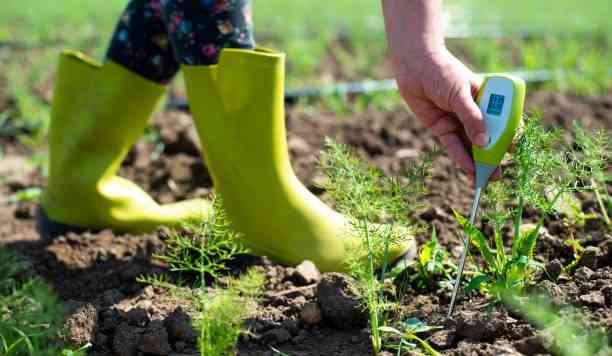Learn About Soil Moisture Meter Before Buying One

You give them water. You move them into the sun. You even talk to them, and still, droopy leaves. What could be the issue? Are your watering habits the problem, or is the soil just of poor quality?
Both are significant issues, and therefore, they’ll be the focus of our piece today. Here, we’ll approach it differently, not the typical “You should water and fertilize the soil this X amount in a day, week, or month.” But from a “How moist soil is before and after watering?” perspective.
That’s where soil moisture meters come in. These small tools help you understand what’s happening below the surface, where roots live and thrive. A soil moisture meter gives you tangible data, data you can use to tweak watering needs specific to your flora.
This piece breaks down everything so that you get to the point of watering your plants with confidence.
What’s a Soil Moisture Meter?
A soil moisture meter is a tool used in gardening to determine the water content of the soil. You stick it into the dirt, and it gives you a reading that helps you make better watering decisions.
All the Different Types, Explained Simply
Let’s start with analog soil moisture meters. These are basic tools—no batteries are required. Just a metal probe (a pointed end with sensors) and a dial that swings to “dry,” “moist,” or “wet.” They’re inexpensive and easy to use, but not always super precise.
Digital meters give numerical readings, and sometimes, the fancier ones include light and pH measurements. They’re powered by batteries and usually come with a backlit screen. Digital soil moisture meters offer a step up in accuracy, making them ideal for serious plant parents and farmers.
Then there are smart soil moisture meters, which pair with apps. These might stay in place in the soil and track soil moisture over time, sending alerts to your phone.
Why Monitoring Moisture Levels Matters
We’ve laid out what a soil moisture meter is and the different types you can pick from, but why does it matter? What’s the big deal about moisture levels? Simple: water isn’t just plant juice. It’s their power source, delivery truck, air conditioner, and personal trainer all in one.
So, when the water’s off, everything else starts falling apart—and your plants will absolutely let you know.
How Soil Type Messes With Your Meter (In Its Own Special Way)
Before you jab that meter into the dirt, take a beat. Your soil’s personality—yes, it has one—can totally throw off your readings if you don’t know what to expect. Here’s how each soil type behaves.
Sandy Soil
Sandy soil drains faster than a gossip at brunch. Water runs right through it, leaving your meter flashing “dry” even if you just gave it a drink. Don’t panic—it’s not ignoring you. It’s just doing what sand does: refusing to hold onto anything.
Clay Soil
Clay is the opposite. It hoards water like it’s prepping for a drought. Your meter may keep saying “moist” long after the roots are silently gasping for air. It’s the soil version of someone who won’t let go of a group text.
Loamy Soil
Ah, loam—the teacher’s pet of garden soil. It holds moisture without going soggy and gives your meter nice, reliable readings. If all soil behaved like this, we wouldn’t need half the gardening advice on the internet.
Potting Mixes
That fluffy stuff in your indoor pots? It’s full of perlite, bark, and peat and loves to confuse your meter. One layer might read Sahara-dry, while two inches down feels like a swamp. Best strategy? Take a few readings, and don’t trust the first one.
Using One Without Wrecking Your Soil
Don’t know how to use one safely? Here’s how you can use one:
- Select a clean section on the soil’s surface and avoid areas too close to the stem where the roots begin to spread out.
- Carefully dig in the meter’s probe two-thirds deep into the root zone.
- Wait a few seconds for the reading. Note the reading.
- To ensure accuracy, repeat this procedure in a few other locations after removing the probe and cleaning it every time.
What the Numbers on the Soil Meter Mean
- 1–3: Dry
- 4–6: Moist
- 7–10: Wet
Note: The above might not work for all meters. So, check your meter reading guide in the manual that comes with the meter. Also, consider your plant type and its individual needs.
Keep It Working Like New
To keep your instrument working:
- After you’re done using a device, clean the soil meter probe using a dry or slightly damp cloth.
- Remove batteries from digital meters during long storage times.
- Ensure you store your soil meter appropriately.
- Never force the probe into hard, dry soil. If the ground is compacted, water lightly and wait before testing.
- If the results you are getting are inconsistent, for instance, a “dry” reading even after wetting the soil, it could be faulty. If the readings still seem off, try recalibrating your meter first. If that doesn’t solve it, it might be time to retire it and bring in a replacement.
How Do Soil Moisture Meters Compare to Just Watering on a Schedule?
The big question here is, do you go by finger test, gut feel, or tech—what’s best?
Finger Test Vs. Moisture Meter
Sticking your finger in the dirt is a start, but it only tells you what’s happening up top. A soil moisture meter goes way deeper—literally. It picks up on all the hidden stuff your fingers miss, so your plants get what they actually need.
Visual Cues Vs. Moisture Meter
Some gardeners rely on leaf texture or plant behavior. Visual clues frequently arrive too late, even when expertise is helpful. A plant may already be under stress if it appears thirsty. Meters help especially with plants that don’t visibly wilt or those with picky moisture needs, like orchids, succulents, or tomatoes.
However, it is not an alternative for observation but rather a complement.
Soil Moisture Meter Slip-Ups (And How to Avoid Them)
Using a moisture meter sounds foolproof—until it isn’t. Here’s how to use yours the right way and keep your plants thriving.
Forcing the Probe on Hard Soil
One mistake beginners make is jamming the meter in hard, damaging roots, or bending the probe. The solution is to measure a few safe inches from the stem and dig them gently.
Leaving the Moisture Meter Lodged in Too Long
Another common error is leaving one that isn’t designed for long-term use in the soil longer than it should. Most instruments are meant for spot checks, not constant monitoring. The remedy for this is to simply confirm with the manufacturer’s instructions to see if your kind is suitable for long-term use.
Using the Meter Inconsistently
Not doing the check on a regular schedule is yet another mistake. Solution? Check your soil every few days, but this might change depending on the season and soil type. Dry, sandy soil changes faster than rich, loamy beds.
Using the Incorrect Meter Probe Length
A short probe soil moisture meter cannot give accurate readings on crops in deep soils. But one with a longer probe will. Short probes for small pots, longer ones for raised gardens, and bigger pots.
Misconceptions That’ll Waste Your Time
Some viral videos make it seem like you just poke a meter in the dirt and let it take over. That’s not the case. These meters are instrumental when making informed watering adjustments, and they never replace proper plant care practices. Regardless, here are a few misconceptions that could be wasting your time but shouldn’t.
Soil Moisture Meters Water Your Plants; They Don’t
Soil moisture meters do not irrigate your plants. They don’t predict tomorrow’s rain or adjust your sprinkler. They’re tools; reliable and helpful, but only for measuring soil moisture.
Readings Should Be The Same In The Same Space; It Can Vary
Readings can vary by location in the same pot or bed. That’s why it’s smart to check a few spots. And yes, the numbers matter more than the colors on the dial. One plant’s “moist” might be another’s version of “soaked.”
When Not to Rely on a Soil Moisture Meter Alone
Even though soil moisture meters are handy, they’re not always reliable. Here are situations where relying on them alone might lead you astray:
- Newly Planted Seedlings
Seedlings often need surface moisture, which meters don’t always detect. The tool might read “dry” even if the top layer is fine for those tiny roots.
- Compacted or Rocky Soil
Hard, dense, or rocky soil can block the probe, damage it, or give off-center readings. Use caution or aerate the area before testing.
- Frozen Ground
Cold-weather gardeners beware—frozen soil can damage the probe and stop accurate readings. If it’s frozen, wait until the ground thaws completely.
- Unusual Growing Media
Plants in orchid bark, LECA, or moss don’t behave like traditional soil. Meters often indicate “dry” even when the material retains sufficient water.
- Specialized Plant Needs
Some plants have tricky watering habits—like succulents or orchids—that require visual checks and timing more than meter readings.
- Signs of Other Problems
Moisture meters won’t detect root rot, nutrient imbalances, or poor drainage. A “perfect” reading doesn’t always mean a healthy plant.
Things to Consider When Buying
Before you buy a soil moisture meter,
- First, consider ease of reading.
- Next, check the probe length. Herbs and houseplants do well with shorter ones. For deep planters, trees, or raised beds, longer probes work well.
- Read multiple reviews on each meter before you trust your tomatoes to any brand.
- Select meters that suit your space. For example, A moisture meter doesn’t require Wi-Fi unless you’re managing a greenhouse or an extensive garden system.
Estimated Soil Moisture Meter Price Range
The characteristics and accuracy of soil moisture meters determine their price. This is a summary:
- Basic analog meters: $8–$15
- Simple needle gauges, no batteries required.
- Mid-range digital meters: $20–$50
- More accurate, may include light, pH sensors, or other checks.
- High-end smart meters: $30–$100+
- App connectivity, data tracking, and advanced features.
Note: You can purchase all soil moisture meter types from physical store outlets and online e-commerce websites, such as Amazon and Alibaba.
One Small Tool, One Big Difference
Watering requires precision every time. A soil moisture meter helps you know the exact moisture environment underground. It also helps users avoid the all-too-common mistake of over- or underwatering their crops.
As seen, soil moisture meters are easy to use, and you can find one that fits your budget. Pairing your moisture meter with a watering log or app can seriously level up your plant care game.
FAQs:
Q1. Do soil moisture meters actually work?
Soil moisture meters measure electric conductivity, not moisture per se. They can be inaccurate depending on the soil being tested, compaction, salinity, and the quality of the probe. They provide helpful comparative readings but can’t always be trusted—to get the best results, supplement with touch tests and calibration.
Q2. What is a soil moisture meter?
A soil moisture meter is a handheld device with metal probes that correctly measures the amount of moisture in the soil by measuring electrical resistance or capacitance and translating it into an easy-to-read scale. Great for gardeners, it supports accurate watering decisions.
Q3. Is it acceptable to keep a soil moisture meter in the pot for an extended length of time?
It depends on the type. Some smart meters are made to stay in the soil and track moisture over time, but most analog and digital meters are designed for spot checks only.
Q4. How often should one use the meter to check soil water levels?
The plant type and season direct the frequency. When it’s hotter, check levels every two to three days. When it cools down, once a week may be enough. It’s less when it’s wet.
Q5. Is it possible to use a soil moisture meter on all kinds of soil?
Performance varies, though. While sandy or gritty soil may exhibit quick shifts, clay-heavy soil may provide delayed readings. For the most accurate snapshot, always test in many locations and select a meter that is appropriate for the type of soil you are using.
Q6. Are Soil moisture meters kid or beginner-friendly?
Indeed, it can be a very good teaching tool! Because analog meters only require a stick to read and don’t require buttons or batteries, they are particularly user-friendly for beginners. It is an enjoyable technique to engage young plant lovers or novice gardeners because it instills awareness and responsibility.



